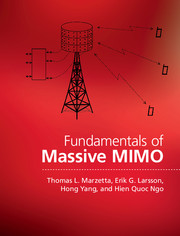Book contents
- Frontmatter
- Contents
- Figures
- Tables
- Preface
- 1 Introduction
- 2 Models and Preliminaries
- 3 Single-Cell Systems
- 4 Multi-Cell Systems
- 5 Power Control Principles
- 6 Case Studies
- 7 The Massive Mimo Propagation Channel
- 8 Final Notes and Future Directions
- A Circularly Symmetric Complex Gaussian Vectors
- B Useful Random Matrix Results
- C Capacity and Capacity Bounding Tools
- D Alternative Single-Cell Capacity Bounds
- E Asymptotic Sinr in Multi-Cell Systems
- F Link Budget Calculations
- G Uniformly Distributed Points in A Hexagon
- H Summary Of Abbreviations and Notation
- References
- Index
1 - Introduction
Published online by Cambridge University Press: 03 November 2016
- Frontmatter
- Contents
- Figures
- Tables
- Preface
- 1 Introduction
- 2 Models and Preliminaries
- 3 Single-Cell Systems
- 4 Multi-Cell Systems
- 5 Power Control Principles
- 6 Case Studies
- 7 The Massive Mimo Propagation Channel
- 8 Final Notes and Future Directions
- A Circularly Symmetric Complex Gaussian Vectors
- B Useful Random Matrix Results
- C Capacity and Capacity Bounding Tools
- D Alternative Single-Cell Capacity Bounds
- E Asymptotic Sinr in Multi-Cell Systems
- F Link Budget Calculations
- G Uniformly Distributed Points in A Hexagon
- H Summary Of Abbreviations and Notation
- References
- Index
Summary
The performance limitation of any wireless network will always be at the physical layer, because, fundamentally, the amount of information that can be transferred between two locations is limited by the availability of spectrum, the laws of electromagnetic propagation, and the principles of information theory.
There are three basic ways in which the efficiency of a wireless network may be improved: (i) deploying access points more densely; (ii) using more spectrum; and (iii) increasing the spectral efficiency, that is, the number of bits that can be conveyed per second in each unit of bandwidth. While future wireless systems and standards are likely to use an ever-increasing access point density and use new spectral bands, the need for maximizing the spectral efficiency in a given band is never going to vanish.
The use of multiple antennas, also known as multiple-input, multiple-output (MIMO) technology, is the only viable approach for substantial improvement of spectral efficiency. While mostly developed during the last two decades, it is noteworthy that a basic idea behind MIMO is almost a century old: in [1], directional beamforming using an antenna array was suggested to permit more aggressive frequency reuse of scarce spectrum – in this case, very low frequency – for transoceanic communication.
MIMO technology is logically classified into one of three categories, whose development occurred during roughly disjoint epochs: Point-to-Point MIMO, Multiuser MIMO, and Massive MIMO. This book is about Massive MIMO, which arguably will be the ultimate embodiment of MIMO technology. The following sections explain these incarnations of MIMO and their important differences. This treatment is intended to be a quick overview, and subsequent chapters will expand upon the concepts introduced here.
Point-to-Point MIMO
Point-to-Point MIMO emerged in the late 1990s [2–11] and represents the simplest form of MIMO: a base station equipped with an antenna array serves a terminal equipped with an antenna array; see Figure 1.1. Different terminals are orthogonally multiplexed, for example via a combination of time- and frequency-division multiplexing. In what follows, we summarize some basic facts about Point-to-Point MIMO. More details, along with derivations of all formulas given here, are provided in Section C.3.
Information
- Type
- Chapter
- Information
- Fundamentals of Massive MIMO , pp. 5 - 18Publisher: Cambridge University PressPrint publication year: 2016
